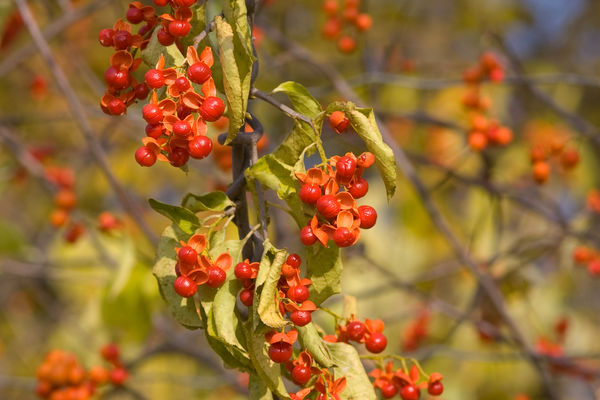
By Sarah Browning, Extension Educator in Lancaster County
Bittersweet berries are a beautiful fall decoration, and gardeners may think growing their own is a great idea. But bittersweet is a fast-growing vine, which can easily get out of control. Vines twine and climb over shrubs and up nearby trees, which can severely damage or kill them. It’s a poor choice for a finished area of an urban landscape, but it does make sense for wild areas, acreages or farms with a back fence, rock pile, old windmill or declining tree where it can scramble. Or, for a smaller in-town landscape, it could be planted in a whiskey barrel or other container to control its growth — just provide a trellis for it to climb.
EASY TO GROW
American bittersweet, Celastrus scandens, is native to north America from Canada to South Dakota and New Mexico. It’s a woody perennial vine or vine-like shrub with lustrous dark green alternate leaves, turning greenish-yellow to yellow in fall. Plants produce non-showy greenish-white flowers, which are easily overlooked by gardeners in May and June.
It is very easy to grow, thriving in any soil type, including dry locations and high pH soil. In fact, one way to slow down its aggressive nature is to purposefully plant it in a location with very poor soil; it will quickly outgrow its bounds when growing in good soil. It blooms and fruits best when grown in full sun.
Plant height is often listed as 20 feet, but it will continue to grow if it has something to grow upon. Plants are hardy to Zone 3.
AUTUMN REVOLUTION
Wild bittersweet plants are dioecious, meaning they have either all male flowers or all female flowers. Only female plants produce berries, but pollen from the male vine’s flowers is needed for berry set. However, a 1:1 ratio of male and female plants is not needed — a single male plant can pollinate several female plants.
The difficulty, until recently, has been that male and female plant lines were not identified at the garden center. So, if unnamed bittersweet seedlings were purchased at a garden center or online, there was no way to know if they were female or male plants.
However, in 2009 Bailey Nursery introduced ‘Autumn Revolution’ a unique bittersweet with “perfect” flowers — meaning its flowers have both male and female structures in each flower. This means gardeners can buy one plant and it will produce the beautiful fruit clusters, avoiding the headache of finding male and female plants. ‘Autumn Revolution’ also has larger-than-normal berries. Michael Dirr, author of “The Manual of Woody Landscape Plants,” describes them as marble-sized and the fruit clusters like a “cluster of grapes.” It’s available from online, mail-order nurseries.
DON’T PLANT ORIENTAL BITTERSWEET
When purchasing bittersweet, make sure you know what species you are buying! A related species, Oriental bittersweet, C. orbiculatus, is considered a priority species by the Nebraska Invasive Species Program. This means it is a top priority for eradication of new or existing populations so it does not become a noxious weed, as it is considered in many other states.
Invasive non-native plants, like Oriental bittersweet, crowd out favorable native plants, degrading habitat for wildlife and insects.
American bittersweet and Oriental bittersweet can be identified by their fruit clusters. American bittersweet clusters are fewer in number but larger, often 2–4 inches in length, and develop at the tip of each vine. Oriental bittersweet produces more fruit clusters, but they are smaller and develop at the junction where a leaf attaches to the main stem. Thus, each Oriental bittersweet vine may have several small fruit clusters scattered along the end of each vine.